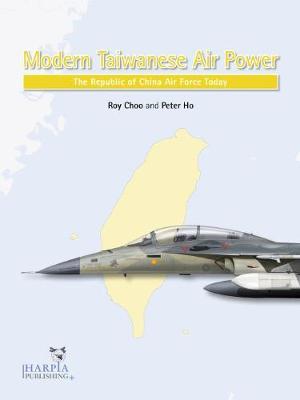
Modern Taiwanese Air Power. The Republic of China Air Force Today. By Roy Choo and Peter Ho. Harpia Publishing Verlags-GmbH, 1090 Wien, Austria. ISBN 978-1-950394-03-6.
Reviewed by David Hobbs
Since the communists seized control of mainland China in 1949 there has been hostility across the straits between the communist People’s Republic of China, PRC, and the Republic of China, ROC, on the relatively small island of Taiwan. On several occasions confrontation has come close to open warfare and the Taiwan Straits remain a potential flash-point.
This soft-backed, 84-page book gives a succinct description of the ROC Air Force, a key component of the Taiwanese armed forces, detailing its equipment and ability to counter an attack by the far-larger communist People’s Liberation Army, PLA, with its component land, navy and air force elements. The author’s wrote their introduction in April 2021 and so this book contains the most up to date material available within the public domain. It follows the successful format used by the publisher in other works that examine the world’s air arms.
The text is divided into five sections which cover the origins and development of the ROCAF over the past hundred years, its structure today, its role in defending Taiwan against an all-out attack by the PLA, aircraft currently in service and future programs. An appendix illustrates the badges of the various command elements, bases, wings groups and squadrons. As with all the photographs and maps, these are in colour. The aircraft and their weapons are described in detail and the authors have clearly studied the ways in which they would probably be deployed and used in anti-surface vessel and ground attack roles as well as in the air defence of Taiwan. Missile systems operated by the ROCAF are also described.
At first the United States undertook to defend the ROC in Taiwan against communist aggression and the high-point of this relationship was a mutual defence treaty signed in 1954. The US Government stood by Taiwan through a series of crises that came close to open warfare in the 1950s but the situation changed radically in 1979 when the US established formal relations with the PRC and ended its formal recognition of Taiwan as a separate state. In consolation Congress passed the Taiwan Relations Act, undertaking to provide defensive arms to allow the ROC to protect itself. The PRC has objected to attempts to sell arms to Taiwan since then with the exception of the sale of 150 F-16A/B fighters in 1992. Since then the US has chosen to limit direct arms sales but, instead, to transfer technology that has allowed Taiwan to produce its own weapons systems such as the F-CK-1C/D fighter. European defence firms have proved more susceptible to Chinese pressure than their US equivalents but the sale of 60 French Mirage 2000-5D/E fighters in 1982 has been the sole exception to the Taiwanese preference for American aircraft and systems but they are now becoming difficult to sustain. Spares are difficult to source and they are the most expensive aircraft in the inventory to operate, a factor that limits their usefulness within the budget-limited ROCAF. It may be that the sale of 66 F-16C/D fighters to Taiwan, finally authorised by the Trump administration in 2019 after more than a decade of Taiwanese pressure, will be used to replace rather than augment the Mirage 2000s. They are due for delivery from 2023.
This informative book describes an air arm that would have a significant role to play in any regional conflict. The authors clearly have a good understanding of their subject and have produced a book that is clearly the result of considerable research as well as being readable. Much is being written by defence analysts about the area denial/anti-access weapons being deployed by the PRC across the South China Sea intended to limit US deployment options. Taiwan has the reverse problem, trying to deny the air and sea-space around Taiwan to the PLA and it has to do so with equipment can no longer be described as the best available. The rapid expansion of the PLA both in terms of quantity and quality since the turn of the century has taken the initiative away from Taiwan. So too has the lack of any defensive alliance and the reluctance of the USA to sell the latest weapons have given its government a difficult problem. It is one that should be watched with close attention from Australia and this book offers an affordable means of gaining knowledge about the ROCAF. It should be read by anyone with an interest in present-day strategy on the Pacific rim and I recommend it.



